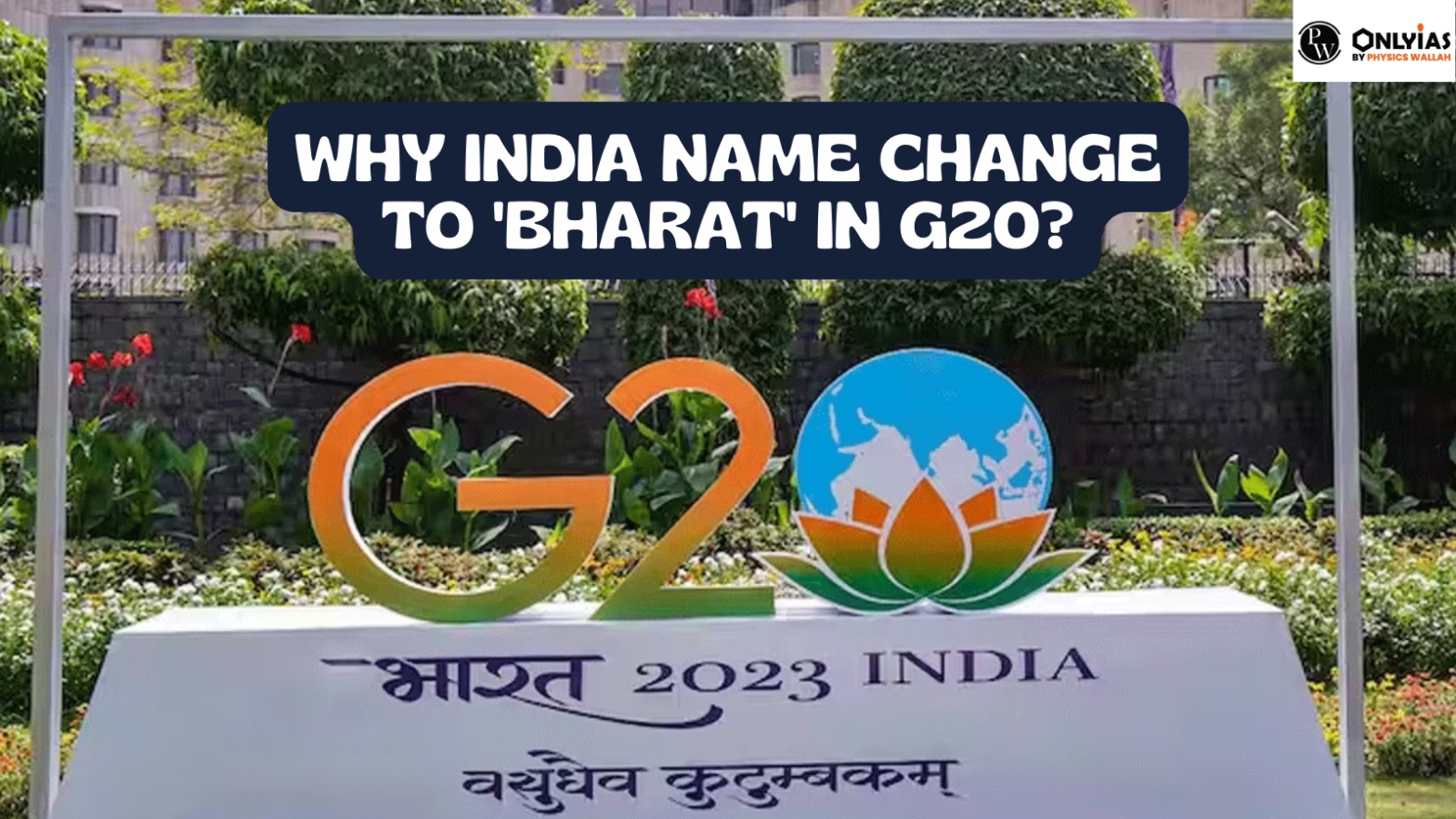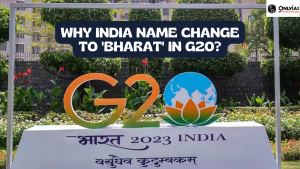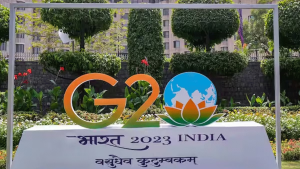![]() Madhavi Gaur
Madhavi Gaur
![]() September 09, 2023 12:11
September 09, 2023 12:11
![]() 9652
9652
![]() 0
0
G20 India name change to Bharat: The contemplation of changing the name of India to "Bharat" has sparked significant discussions and debates in recent times. India, a nation rich in history and culture, has been known by its current name for decades. To know more check out this article.

India name change to Bharat: The contemplation of changing the name of India to “Bharat” has sparked significant discussions and debates in recent times. India, a nation rich in history and culture, has been known by its current name for decades, but the idea of reverting to its ancient moniker, “Bharat,” carries both historical significance and contemporary implications.
This potential transformation reflects a broader effort to shed colonial legacies and assert a renewed sense of national identity. In this exploration, we delve into the reasons, debates, and potential consequences surrounding the proposed India name change to “Bharat.”
Amidst swirling speculations regarding a potential proposal by the Central government to rename the country from India to ‘Bharat,’ Union Minister Anurag Thakur has officially clarified that these are merely “rumors.”
This development has ignited a political dispute within India, sparked by a G20 dinner invitation issued in the name of the ‘President of Bharat,’ instead of the customary ‘President of India.’ This controversy has fueled suspicions of an impending name change for India, just ahead of a special parliamentary session.
In response to this, the Opposition, united under the banner of ‘INDIA’ with the objective of challenging the ruling National Democratic Alliance (NDA) in the upcoming Lok Sabha elections, swiftly convened and criticized the government’s actions. Furthermore, a government publication detailing Prime Minister Narendra Modi’s participation in the 20th ASEAN-India Summit during his visit to Indonesia referred to him as the ‘Prime Minister of Bharat.’

India has two names, “India” and “Bharat,” due to historical and linguistic reasons. The language employed in Article 1 of the Indian Constitution stipulates that “India, known as Bharat, shall constitute a union of states,” explicitly referencing both the English and Hindi appellations for the nation, which achieved independence in 1947 following nearly two centuries of British colonial rule.
India Name Change to Bharat: The Constituent Assembly of India engaged in passionate debates over Article 1 of the Constitution, which would define the newly independent nation. The discussions covered various aspects, including the necessity of two commas and the order of the words ‘India’ and ‘Bharat’ within the article. Let’s delve into who said what and how the article was eventually adopted.
The initial debate on Article 1 was scheduled to commence on November 17, 1948. However, at the suggestion of Govind Ballabh Pant, the deliberation regarding the name was deferred to a later date. On September 17, 1949, Dr. B. R. Ambedkar presented the final version of the provision to the Assembly, incorporating both ‘Bharat’ and ‘India.’
During these discussions, several members voiced their objections to the use of ‘India,’ perceiving it as a reminder of the colonial era. Seth Govind Das from Jabalpur advocated for placing ‘Bharat’ ahead of ‘India.’ Additionally, there was a common request among many members to clarify that ‘India’ served as the English-language substitute for ‘Bharat.’
India was under British rule for approximately two centuries until it achieved independence in 1947. Those who advocate for the use of “Bharat” argue that the name “India,” which is widely recognized globally, has its origins in the colonial era.
The name “India” has its roots in ancient Western civilizations, who derived it from the Sanskrit word for the Indus River, known as “Sindhu.” This term was later adopted and adapted by the British Empire.
Also Check:
India Name Change to Bharat: The recent use of the term “President of Bharat” in official G20 Summit invitations has generated significant controversy. This development, occurring shortly before a special session of Parliament, has heightened political tensions.
The term “Bharat” has also made an appearance in a G20 booklet intended for foreign delegates, titled “Bharat, The Mother of Democracy.” While this decision is the subject of intense debate, it may also have implications for the technology industry.
If this change becomes official, it could potentially impact websites using the ‘.in’ domain, leading to an identity challenge. If the official name of India transitions to “Bharat,” there is a possibility that the domain names for these websites will require adjustments. However, alternatives such as “.BR” or “.BH” are already in use by Brazil and Bahrain, respectively. Additionally, “.BT” is claimed by Bhutan. If longer top-level domains (TLDs) are allowed, there is a chance that our country might adopt options like “.BHRT” or “.BHARAT.”

It’s important to note that this change is not expected to affect the functionality or existence of these websites, as they will continue to operate as usual. The alteration primarily concerns the nomenclature of the websites.
During its tenure, the government led by Modi has taken steps to distance India from what it perceives as remnants of British colonial rule and to shed what it refers to as its “colonial baggage.”
These efforts have included renaming streets and structures associated with both India’s Mughal and colonial history. For instance, in 2022, the government renamed Rajpath, a 3-kilometer boulevard formerly known as Kingsway that runs through the heart of New Delhi. The new official name, Kartavya Path, was chosen to eliminate any traces of colonial influence, as stated by the government.
India Name Change to Bharat: In 2018, three Indian islands that were originally named after British rulers were also renamed in the Andaman and Nicobar Islands to erase these symbols of slavery.
However, the use of “Bharat” on the G20 invitations has sparked concerns among opposition leaders. Shashi Tharoor, a former diplomat and prominent lawmaker from the main opposition Congress party, expressed his hope that the government would not entirely abandon the name “India.” He highlighted the incalculable brand value associated with “India,” which has been established over centuries.
Tharoor, known for his non-fiction work “Inglorious Empire,” which criticizes colonial Britain’s rule of India, emphasized that while there is no constitutional objection to referring to India as “Bharat,” it is essential to preserve the name “India.”
In July, leaders from 26 Indian opposition parties formed an alliance called INDIA (Indian National Developmental Inclusive Alliance) in an effort to challenge Modi in the upcoming general election in 2024. The alliance aims to promote a sense of nationalism and uphold India’s democratic institutions. This move reflects growing concerns about Modi’s government, including its Hindu nationalist politics, crackdown on dissent, and increased control over democratic institutions, as highlighted by rights groups and opposition lawmakers.
The term “Bharat” boasts profound historical and cultural origins, tracing its roots to Puranic literature and the epic Mahabharata. In the Vishnu Purana, “Bharata” is described as the region nestled between the southern sea and the snowy Himalayan mountains to the north. It embodies a religious and socio-cultural entity, transcending mere political or geographical boundaries. Additionally, “Bharata” is the name of a legendary ancient king, revered as the progenitor of the Rig Vedic tribes of Bharatas, symbolizing the forefather of all the subcontinent’s inhabitants.
The name “Bharat” for India has ancient origins and is rooted in Indian mythology and history. It is derived from the Sanskrit word “Bharata,” which has several historical and mythological connotations:
The name “India” finds its derivation in the word “Indus,” which pertains to a river coursing through the northwestern part of the subcontinent. The ancient Greeks referred to the people residing beyond the Indus as “Indoi,” signifying “the people of Indus.” Subsequently, the Persians and Arabs adopted the term “Hind” or “Hindustan” to denote the land of the Indus. European adoption of the name “India” stemmed from these sources, ultimately becoming the official appellation of the nation following the era of British colonial rule.
While “India” has been the widely accepted and official name of the country in modern times, “Bharat” continues to hold cultural and mythological significance in India. The proposal to officially use “Bharat” alongside “India” reflects a desire to reconnect with this historical and mythological heritage.
The discourse concerning the nomenclature of the nation is not a recent development. When the Constituent Assembly was in the process of crafting the Constitution in 1949, there emerged a schism of opinions concerning the appellation.
Certain members contended that “India” bore the vestiges of colonial subjugation and aimed to accord precedence to “Bharat” in official records. Seth Govind Das, hailing from Jabalpur, ardently advocated for the primacy of “Bharat” over “India,” underscoring that the latter merely constituted an English translation of the former.
Hari Vishnu Kamath drew attention to the Irish Constitution, which, upon attaining independence, altered the country’s name, serving as a precedent for the utilization of “Bharat.”
Hargovind Pant posited that the populace desired “Bharatvarsha” and disavowed the term “India” foisted upon them by foreign rulers.
In 2015, the Central government opposed a name alteration, asserting that the matter had been extensively deliberated upon during the Constitution’s drafting phase.
The Supreme Court, in both 2016 and 2020, dismissed petitions seeking to rename ‘India’ as ‘Bharat,’ affirming that both “Bharat” and “India” were explicitly referenced in the Constitution.
The term “Hindustan” bears profound historical significance, particularly in the region of Punjab. Guru Nanak Dev, the founder of Sikhism, made mention of “Hindustan” in Gurbani, while Guru Teg Bahadur is renowned as the guardian of “Hind” and its faith.
Shah Muhammad documented the confrontations between the British and Sikhs as a struggle between “Hind” and Punjab.
Notably, the Ghadar Party and freedom activists invoked “Hindustan” in their movements, endowing it with historical relevance in the annals of Punjab’s history.
Here is the list of countries around the world that changed their names:
<div class="new-fform">
</div>

Latest Comments